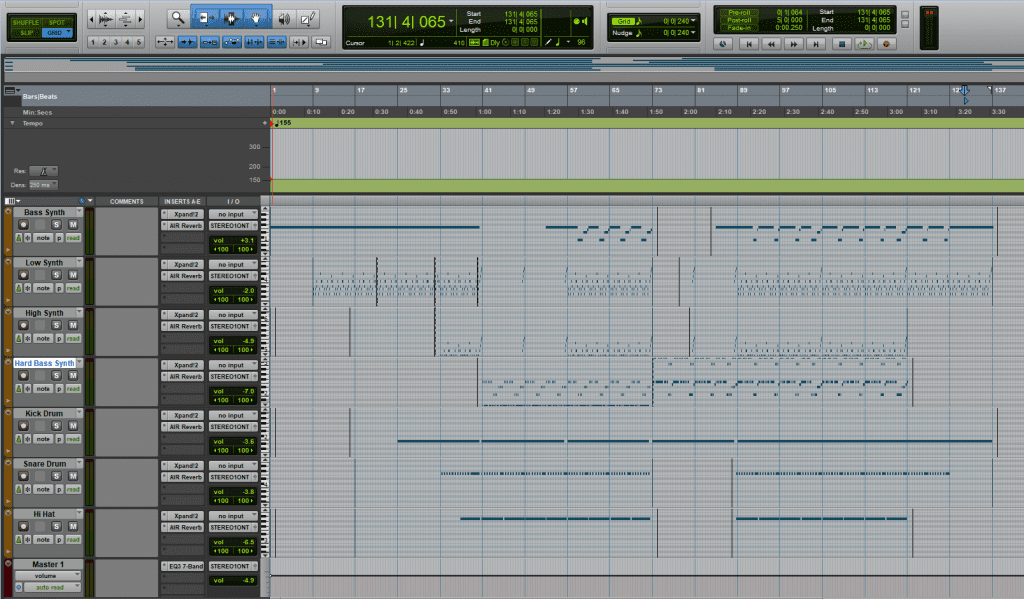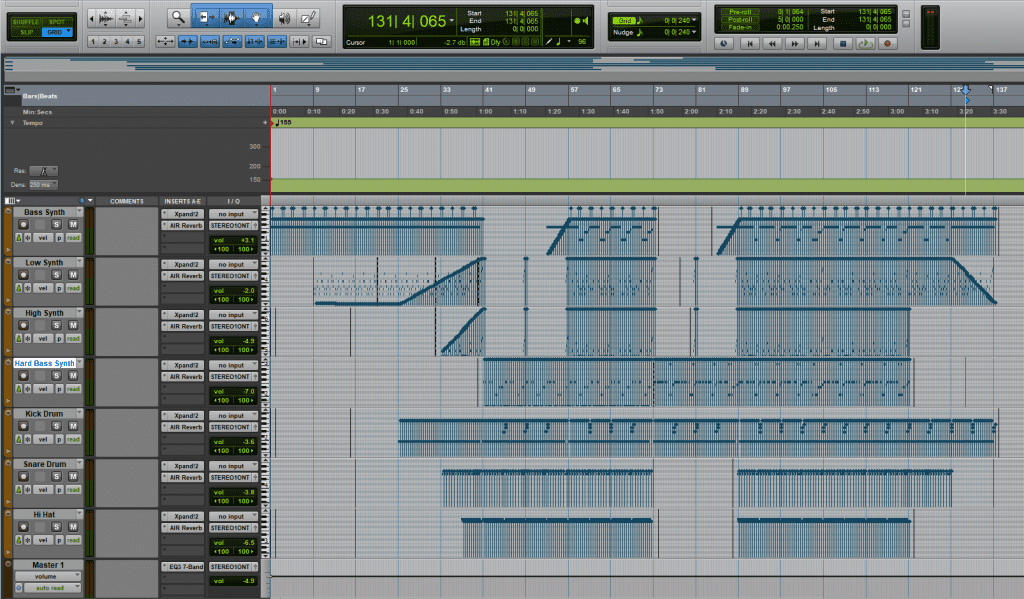
Frantic Dance – The ProTools Session
The sequencing for this 155 bpm song began with a bassline, which played notes on every 16th note. This created a bass riff with a sense of urgency right from the start of the song, and this was the intended effect because it was meant to signify the start of a long build to the first main section, where the hard bass synth kicks in. This effect from the sequencing of the bass, alongside the ‘4 on the floor’ kick drum beat, the snare on every second beat, and the syncopated hi-hats, helped to build up from the intro and release the tension at the drop, where the drums kicked in fully and the bass riff changed into something harder and more urgent than before.
The hard bass synth consisted of the same bassline repeated over and over again, before it changed up an octave on the second drop, still using the same notes but on a higher pitch than before. This was done to add some variety to the song, showing a change from one part (in this case a main section/build up) to the next (the drop and following build up to the next main section), allowing the song to continue flowing at a constant rhythm. It was done in this manner because the rhythm is arguably one of the most important parts of any song, and bass synths/instruments, alongside the drums, are considered rhythmic instruments which all help to play a core part in maintaining the tempo of a song, and are vital to use for build-ups and drops as that is where the rhythm of the song can change if it done correctly.
The High Synth and Low Synth tracks played the same riff at different octaves to one another, providing a melodic riff over the top of the drums and the basslines. It was important to have some higher pitched synths in the song because it would have made the lower frequencies too crowded otherwise, making the song sound muddy (where there is too much noise in the 400-800 Hz frequencies, causing the song to lack clarity/definition) and retracting from the overall quality of the sound. This ‘muddiness’ is not ideal for a dance song, as it needs to have enough clarity so people can understand it was well as having enough low-end frequencies to add to the rhythm to keep people dancing.

Frantic Dance – The use of Velocity in the sequenced elementsThe velocity automation in the image above helps to show what parts of the song built up and on what tracks it was used. For example, the High/Low Synth tracks used it at the end of the intro to signify a build up to a drop, where the Hard Bass Synth starts. As drops are an important part of an EDM song due to the high levels of energy it contains, since it is the release of tension built up in the ‘build ups’ just before, I wanted my drops to sound like they had a big impact when they hit, and to make sure that was the case I allowed the synths to build up to those drops using velocity, and cut those synths out so the Hard Bass Synth and the drums could take over the drop. This way, the rhythm changed and the sound was relatively minimalistic, which was recommended for a good drop, aiming for an effect where, simply, people would want to dance to it due to its rhythm and minimalism.
The main bass synth also benefited from the velocity applied upon it, but in a different way. I used velocity to put emphasis on different notes within the bass riff, adding variety to the sounds throughout the song, but most notably on the intro. This was to set the rhythm for the piece and help maintain it as the song went on, including the automated fade ins that were drawn into ProTools, because of the emphasis I wanted to put on the rhythm to help make the song easier to dance to, which is quite fundamental in an EDM song because, if you can not dance to it, then it is not serving its purpose as an EDM song. The kick drum also received some automation on the build ups for a similar reason: it is a rhythmic instrument and I felt that using velocity in such a manner would not only help to keep the tempo constant, but also put emphasis on the build ups alongside the other synths.

Leave a Reply